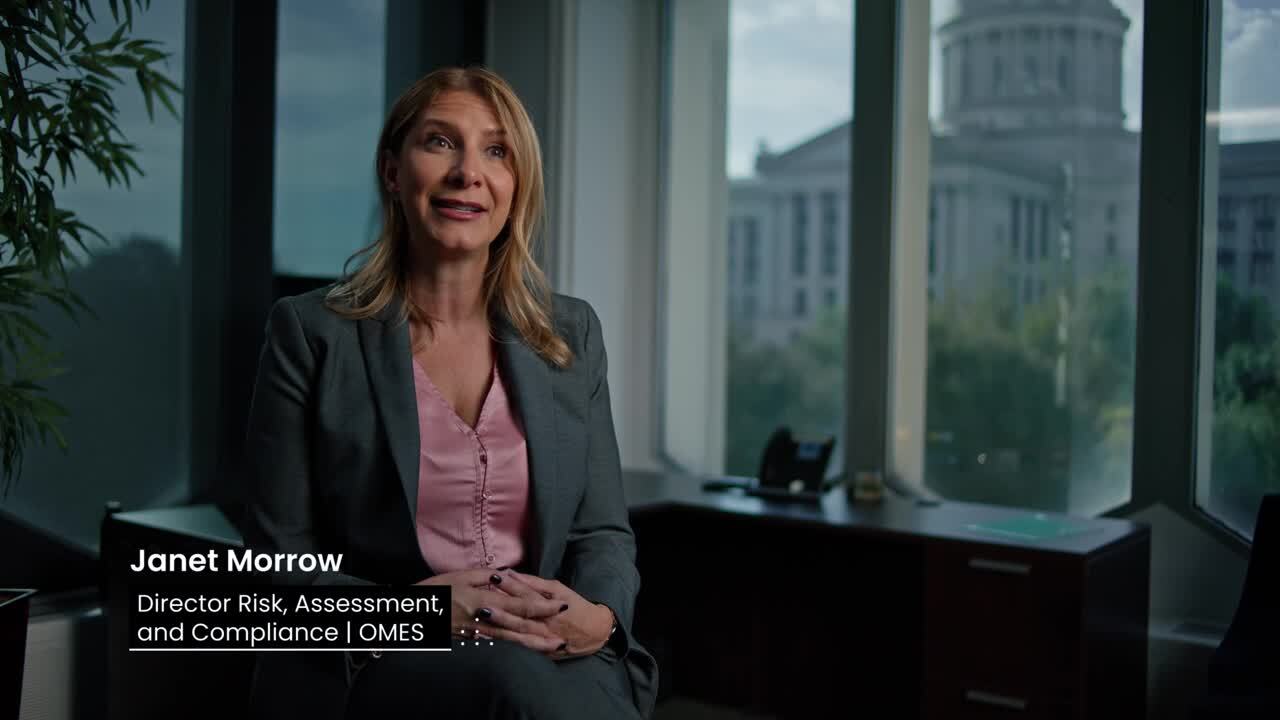

The State of Oklahoma is the first US state to tap into Celonis Process Intelligence. In less than twelve weeks, they brought visibility into Procurement, cut maverick spend, and slashed audit cycle times. Their vision? Saving tens of millions of tax dollars per year to give back to the community.
Can you recall a time you’ve used a government service — be it to claim social benefits or renew your driver’s license — and left genuinely satisfied? It’s a rare occurrence for most. But there are pioneers in the public sector aiming to overhaul decades-old, regulation-ridden processes and create a modern, highly efficient public service.
Meet the State of Oklahoma.
Governor J. Kevin Stitt and the $12.6 billion apparatus behind him are focused on digitally transforming the government. Their goal: streamline workflows, offer smoother experiences, save tax dollars. One key technology that enabled them to squeeze massive value from Procurement, strengthen fiscal responsibility, and do more with less is process mining.
With Celonis, the market leader in process mining, the state managed to oversee 100% of their spending, stop maverick buying, minimize fiscal and legal risks, and save millions — all in twelve weeks. Going forward, they could save tens of millions of dollars each year.
Billions spent without oversight
The driver behind this massive project is the Office of Management and Enterprise Services (OMES). It’s the state's central finance agency, responsible for overseeing the distribution of billions of dollars a year to make sure tax dollars are spent wisely. The main hurdle? A complex, tedious procurement process that is hard to see — let alone optimize.
In April 2023, a report from Oklahoma’s Legislative Office of Fiscal Transparency (LOFT) revealed that the state’s purchasing was far from compliant: Oklahomas’s agencies spent $3 billion without oversight in 2022, about a quarter of their budget.
LOFT’s scathing verdict: the state’s purchasing was “time consuming and vague on exemption use,” and the lack of overview posed “financial and legal risks to the state.”
Dissecting a broken Procurement process with flawed methods
Oklahoma’s auditors (and buyers) needed to get their house in order, fast.
“Our duty is to be good stewards of taxpayer dollars, so we took the LOFT report to heart and wanted to make sure we addressed every single data point,” says Janet Morrow, Director of the Risk, Assessment and Compliance division (short RAC).
The team’s mission: scrutinize the $3 billion in potential rogue spend and audit all of Oklahoma’s 122 agencies by the end of 2023. No easy feat, given that her audit team of six people has to oversee thousands of transactions every month.
Add a 61-point requisition checklist and a fragmented system landscape forcing the RAC team to jump between emails, spreadsheets, and law books, and you can easily see why it can take them up to three years to audit a single agency. Which not only means compliance issues were usually found when the damage was already done – they also could only oversee a minuscule portion of the state’s spending: eight out of 122 agencies per year to be exact. The only way to audit the state’s entire spend within 2023 seemed to be to outsource to the private sector for a hefty $12.4 million.
Oklahoma leads the way
The fact that the State of Oklahoma found a solution that was not only 200x more efficient but $11.4 million less expensive is likely thanks to the tech enthusiasm of Jerry Moore. The OMES Deputy Director and State Chief Transformation Officer discovered Celonis through a pitch.
>> Read his blog on why process intelligence will change the game for government efficiency
When put to the test, Jerry Moore says, software vendors would usually deliver one of two things: “a pile of coal or a pile of gold. And Celonis struck pure gold.” Praise Joe McIntosh, the state’s CIO, unanimously agrees with.
“Within one week of implementing Celonis, we had data-driven insights that helped us understand our key financial challenges and how to address them.”
Joe McIntosh, State Chief Information Officer, OMES
While Celonis Process Intelligence – powered by process mining and AI – has long been mission-critical for many corporate players (think PepsiCo, Uber, FedEx, Cisco, Wells Fargo and more), the technology is still relatively uncharted territory for the public sector. In fact, Oklahoma is the first state to tap into process mining, after Carashoft included Celonis in its GSA schedule in early 2023.
Taming the octopus
Analyzing data from their ERP system PeopleSoft, Celonis gave OMES a living, breathing digital twin of their Procurement process, end-to-end. Think of it as an x-ray that shows how any process truly runs — not how you think it runs. “We saw we had around 3,000 unique approval processes in Procurement,” says Moore. “It’s like trying to tame an octopus.”
But Celonis’ benefits don’t stop at transparency. Combining deep process insights (delivered by process mining) with a decade of process improvement knowledge and AI, Celonis:
Gives auditors an overview of which buyers are out of compliance.
Flags POs in real time that need to be corrected.
Gives agency buyers AI-driven recommendations on how to correct them.
Once powerless when it came to preventing common purchasing problems such as exemption misuse or split POs, the RAC team can now course correct on non-compliant POs in real time and offer additional training to purchasing agents.
Auditing at the “speed of light”
Armed with this process intelligence, they also audited the spending of all 122 agencies in just four months. A little reminder: at their previous pace of auditing eight agencies per year, it would have taken them up to 15 years to get the job done.
“We went live with Celonis in early June, and we have completed the review of all 122 agencies as of July 1st.”
Janet Morrow, Director Risk, Assessment and Compliance Division, OMES
“What used to take me days in PeopleSoft, now takes me seconds to pull in Celonis,” says Blaine Bridges, OMES Assessment and Standards Manager. “It's very exciting to see that kind of data at your fingertips. We've never had anything close to that.”
In less than twelve weeks, his team reviewed more than 24,000 POs worth $4.58 billion — before they went out to vendors. With this live view, the state can clearly better serve taxpayers, making sure their dollars find their way to the right missions, supporting schools, parks, libraries, or police and fire departments.
Saving tens of millions through better contract usage
The second major benefit of Celonis: the state can maximize usage of centralized contracts to secure better rates. To date, they’ve identified over $174 million in potential savings — just by using state-wide contracts at scale.
“With reviewing billions in spend, there's got to be an opportunity to save tens of millions of dollars of taxpayer money.”
Janet Morrow, Director Risk, Assessment and Compliance Division, OMES
For example, Celonis flags POs that are erroneously using exemption codes or going out as ‘sole sources,’ making it possible to obtain competitive bids. Now, the RAC team can proactively lead the buyer to using contracted vendors instead. “Which means we’re benefiting from better legal protection and state-use fees,” says Janet Morrow. Her vision: using their vendor pool whenever possible, to give the state‘s purchasing director leverage to renegotiate contracts and lower the tax burden on Oklahoma’s citizens.
Doing (much) more with less
Giving Oklahoma’s people more for their money is high on the state’s priority list. “Anytime you make a government operate more efficiently, you’re able to do more with less. Celonis not only helps us save money, but deliver better services at a higher velocity,” says Jerry Moore. One example: they’ve redirected six FTEs previously charged with auditing state-issued credit card transactions to other fields, because Celonis can do the job faster, better and more cheaply.
“We’re finally data-driven in our approach of how we deploy resources. We know exactly where to focus our efforts to solve issues, instead of just adding another approval step to improve compliance.”
Jerry Moore, OMES Deputy Director and State Chief Transformation Officer
Next stop: Standardizing Procurement across the State
Jerry Moore and the RAC team are now engaging with other agency leaders to spread Celonis Process Mining across Oklahoma's government, for example in grants management and IT service. “We’re finding opportunities left and right to be more efficient.”
His next imminent project: accelerating and standardizing the state’s tangle of Procurement processes. Before Celonis, their Procurement cycle would average 110 business days – about six months. "That’s so long that vendors would forget that they even put in a bid,” says Moore.
Within a few weeks, OMES boiled the process down to 46 days. “This is what we cut just by holding ourselves accountable,” says Moore, emphasizing the potential to shorten other agencies’ approval processes, too.
His outlook for the state’s digitization journey with Celonis is bright: ”We are just scratching the surface of what process intelligence can do for the State of Oklahoma. Wherever there's a process, there's an opportunity to improve it with Celonis.”
Ready to start your own journey?
Ready to talk to Celonis expert and learn more about Celonis Execution Management System? Fill out this form and we'll be in touch shortly.










